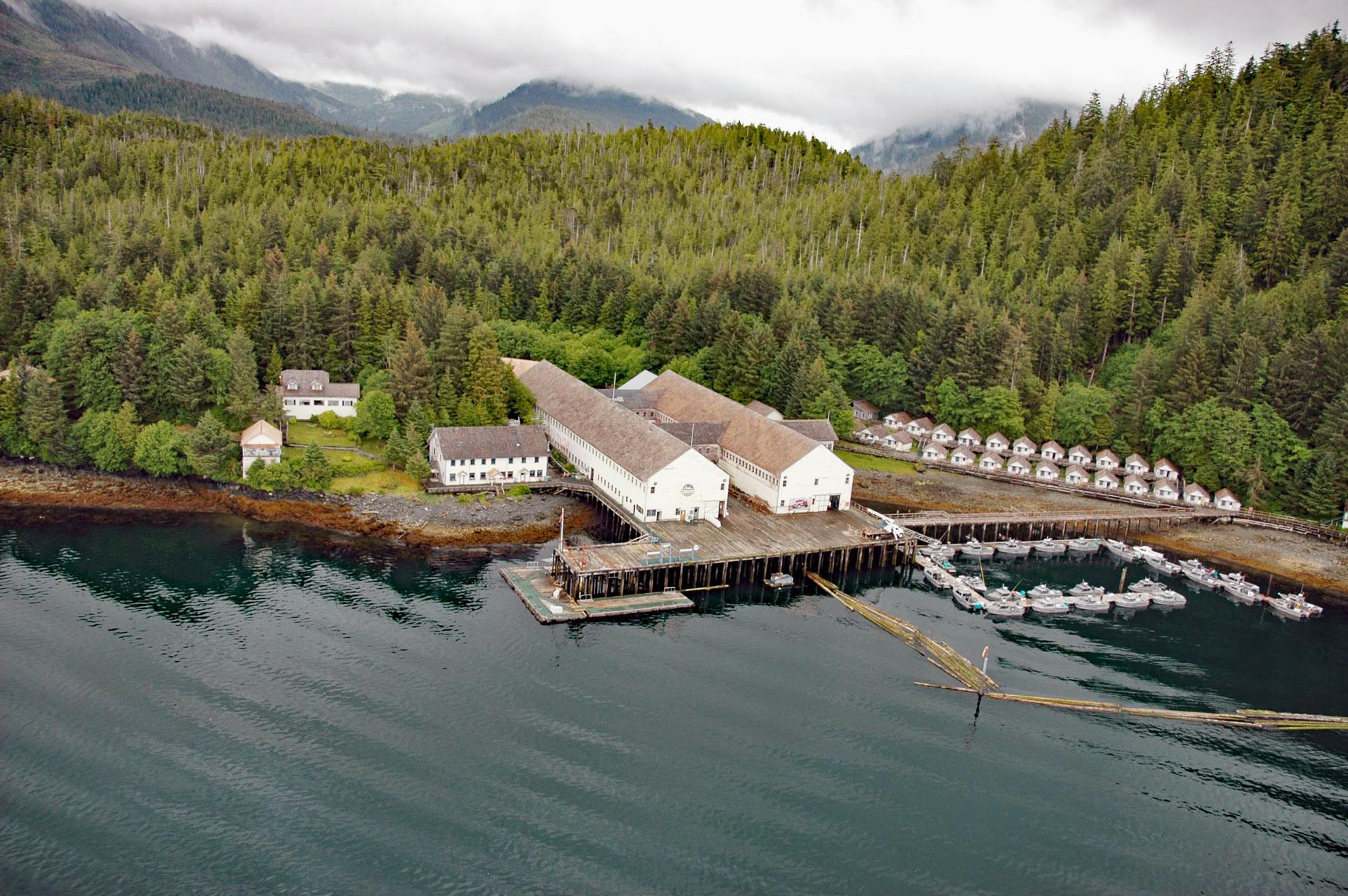Waterfall is a historic cannery situated on the west coast of Prince of Wales Island on Ulloa Channel, adjacent to Port Refugio on Suemez Island, approximately 145 miles (234 km) southeast of Sitka and 60 miles (97 km) west of Ketchikan, Alaska. The cannery was named for a cascade on a nearby stream that provides water to the facility via a pipeline. Ulloa Channel was originally named ‘Canal Ysla de Ulloa’, possibly for Francisco de Ulloa, a Spanish explorer, by Juan Francisco de la Bodega y Quadra and Francisco Antonio Mourelle who also named Suemez Island in 1775-79. The rocks forming Ulloa Channel, Suemez Island, and this portion of Prince of Wales Island represent the Port Refugio Formation that consists of an interbedded sequence of greywacke, conglomerate, siltstone, shale, and some limestone. This formation developed between the Ordovician and Permian periods, or 450 to 250 million years ago, and is part of the Alexander terrane that accreted to the North American continent and extends north from southeastern Alaska into the Yukon Territory and westward into the Wrangell Mountains. After the Last Glacial Period, Pacific salmon began to colonize the newly formed watersheds that appeared as the glaciers retreated. Salmonid remains have been found in some of the oldest archeological sites in the Prince of Wales Archipelago, including a shell midden 9,000 years old on Heceta Island.
The Pacific Coast salmon fishery is ancient. Traditionally, the Indigenous Peoples fished heavily in the coastal waters and tributaries for both food and trade purposes. According to oral tradition, the earliest Tlingit people traversed across Prince of Wales Island from the east following a route up the Harris River and then down to Klawock Lake in search of new fishing territories. The first recorded contact with Europeans occurred in 1779 when two Spanish frigates arrived, the Favorita commanded by Ignacio de Arteaga, and the Princesa. also known as Nuestra Señora del Rosario, commanded by Bodega y Quadra. Within three days the Tlingit were trading fish and furs in exchange for new technologies and materials. By 1792, there were thirty vessels trading along the Southeast Alaska coast with the majority being Americans engaged in the maritime fur trade. A small local salmon market was developed in response to their provisioning needs. In 1867, the Alaska Purchase transferred the territory from Russia to the United States. In 1872, the commercial salmon fishery began with a saltery established at Klawock. In 1889, there were 12 canneries operating in Southeast Alaska and sockeye salmon was the only species being targeted commercially. By 1900, the entire coast from California to the Bering Sea had become the base of the largest salmon industry in the world. In 1907, fish traps were developed to more efficiently increase the yield from a rapidly declining salmon population. By 1912, the number of canneries had increased to 51 and in order to stay competitive they all used fish traps. In 1927, there were 82 canneries operating 575 fish traps that caught 74 percent of all commercial salmon. The number of canneries in Southeast Alaska peaked at 134, but by 1949, due mostly to overfishing, only 37 of these canneries were still operating.
Several Norwegians became prominent in the development of salmon canneries in Alaska. Most notably, Peter Thams Buschmann organized several canning companies and built at least five canneries. Several of Buschmann’s five sons were also active in the salmon industry. Eigil Buschmann first went to Alaska in 1894 with his father and his brother, August Buschmann who had built a cannery in Mink Bay at the Boca de Quadra fjord the previous year. In 1907, Eigel took the purse seiner Ruth, the first powered purse seiner in the Alaska Territory, and fished for the cannery at Hunter Bay. From 1911 to 1912, he started the Oceanic Packing Company with Craig Millar and Frederick C. Johnstone and built the Waterfall cannery. In 1913, during the industry consolidation, the facility was sold to Alaska Fish Company which had been organized by Johnstone and Fremont King. In 1924, Waterfall Cannery was sold to Great Atlantic & Pacific Tea Company, owner of the nationwide chain of A&P stores, and was operated by a subsidiary called Nakat Packing Company where Eigil Buschmann was general superintendent. Historically, the Waterfall Cannery had a wharf and store with some fishermen’s supplies, gasoline, fuel oil, and radio communication during the canning season. In 1932, a major expansion added a warehouse, marine railway, oil dock, hydroelectric dam, power lines, cable house, machine shop, storage room, mess hall, bunkhouses, four seiners, and a fish tender. In 1936, Waterfall produced 220,000 cases, with 96 half pound cans per case, of coho salmon for the year, setting a record for a single Alaska cannery. In 1969, New England Fish Company purchased the assets of Nakat Packing Company, including Waterfall Cannery, but closed the operation in 1971. In 1980, the property was purchased and renovated as a sportfishing lodge. Read more here and here. Explore more of Waterfall Cannery and Ulloa Channel here:

